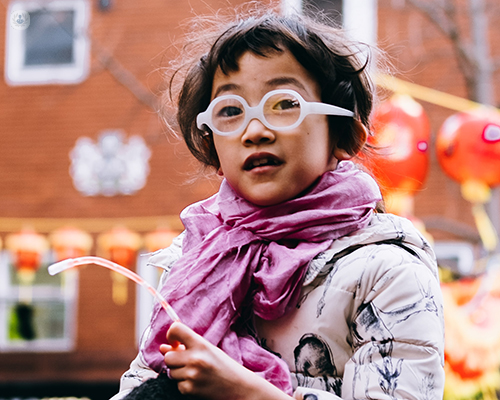Treatment for myopia: how atropine is used
Escrito por:Myopia (short-sightedness) is growing increasingly common in the UK and other countries. It can cause difficulties in everyday life.

We spoke to Dr Annegret Dahlmann-Noor , an expert ophthalmologist who explained to us how atropine can help manage myopia and whether atropine eye drops are safe to use.
Why does myopia occur?
Myopia happens when the eyeball grows a little bit longer than it should in a child. In newborns, the eye is 16 – 18mm long, and in adults, approximately 24 mm in adult. When the eyeball grows a little bit longer, this leads to myopia.
People who are short-sighted can see things relatively clearly close-up, but things in the distance are blurry. Myopia is linked to eye growth and usually occurs during childhood or early teenage years when your eyes grow the most.
Myopia changes the structure of the eye. If you do an ultrasound, you can see the eyeball has become a bit longer than the average eye. People who have a high degree of myopia generally have an eye that is longer and shaped a bit like a rugby ball: it is shorter in the side-to-side than the front-to-back direction.
Are atropine eye drops safe for treating myopia?
Yes, atropine at low concentrations is safe to use. During hospital visits and for other conditions, a high concentration is sometimes used, such as 1%, and this can cause dry eyes, dry mouth, drowsiness or restlessness and a flushed face.
However, for myopia, very low concentrations are used, typically 0.01%, and none of these side effects have been reported.
Atropine slightly relaxes the muscle on the inside of the eyes, the same muscle that controls the near focus. The atropine can enlarge the pupil by a fraction of a millimeter. Atropine can make things slightly blurred when looking at them up closely.
With atropine that is of low concentration, trials have shown that the risk of side effects are very low.
Common adverse effects of low concentration atropine eye drops are:
• Sensitivity to light, because of the slight enlargement of the pupils
• Slight blurring of near vision
For children who find they become sensitive to light, tinted or photochroic lenses that darken in bright light are usually effective at managing this. If they can’t read well, then they can wear focus glasses so they can see better.
As with all eye drops, children can also develop itchy eyes (allergic conjunctivitis).
How effective are atropine eye drops in stopping myopia?
Clinical trials have been done in East Asia. Because children there are mostly of Chinese origin, trials are now underway in Europe and USA to find out how effective atropine is in ethnically diverse countries and cities such as London.
From the trials in East Asia we have learnt that low-concentration atropine (0.01 to 0.05%) is effective and safe, and that treatment needs to be gradually weaned off when the eye growth stabilises, usually after the age of 15 years. Whilst it cannot stop myopia completely, it slows down the worsening by up to 50%
Atropine has been used for over 20 years in East Asian countries, as there are more people there who are short-sighted. For example, over 95% of 18-year old young men in Taiwan are short-sighted, and it is very similar in other east Asian urban areas. In Europe, myopia is becoming more common now and affects twice as a many people than 50 years ago. Now 25% of young people across Europe have myopia.
At the moment atropine is not yet licensed for use in the UK. Until the clinical trials are done, it will continue to be limited to specialist clinics.
Can atropine eye drops be bought over the counter without a prescription?
No, and I don’t think the will ever be, as atropine is a prescription-only-medicine, and it will always require a prescription by a licensed practitioner.
How do you administer atropine drops?
Atropine drops come in a bottle that once opened can be used for 28 days and it's used once a day. We ask parents to use 1 eye drop in each eye at bedtime. The most important thing when administering the drops is that the head is well supported, for example by asking the child to lie down on a sofa or when they are already in bed. Gently pull the lower eyelid down and slip one drop onto the surface of the bottom part of the eyeball.
For more information on treatment for eye issues such as myopia you may like to book an appointment with a leading ophthalmologist such as Dr Annegret Dahlmann-Noor . Visit her Top Doctors profile today for more information.


